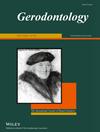Policy Options to Complement the New Canadian Dental Program Enabling High Quality Care for People With Disabilities and Older Adults
Abstract
Background
The newly announced Canadian Dental Care Plan (CDCP) particularly aims to reduce financial barriers to dental care for individuals living below a family income threshold. The Canadian government has also launched an “Oral Health Access Fund” to support projects aiming to address financial barriers to dental care for older adults, those with disabilities and other groups. Evidence from programs implemented elsewhere in the world could inform policy decisions and address such non-financial barriers for older Canadians and those with disabilities.
Aim
To identify dental programs and policies in OECD countries focusing on people with disabilities and older people, and to outline how they might be applied to the Canadian context.
Methods
The strategy for this narrative literature review comprised a combination of Medical Subject Headings (MeSh) or their equivalent, title/abstract keywords, truncations, and Boolean operators. Medline (Ovid), Embase (Ovid), CINAHL and Scopus were used. The searches were limited to English language publications involving programs and policies in all OECD countries. All searches ran from inception to January 25, 2023, with no restrictions on publication time.
Results
The search identified 129 articles eligible for review. Findings were categorized as (1) interventions at the institutional-level (subdivided into patient-, professional- and community-focused programs) and (2) interventions at the governmental-level (subdivided into universal, population-specific, and community-based programs). Evidence suggests that targeted, integrated coaching or education programs for oral health care are beneficial, especially when programs are constantly evaluated and improved. Programs with a unified network system that integrates various relevant organizational and health domains have demonstrated to be most effective in the improvement of oral health care and overall health. Dental and medical healthcare workers play a crucial role in improving oral health outcomes and need motivation and fair compensation when caring for older people.
Conclusions
There is limited quality evidence supporting approaches to improving oral health care and oral health for older people and those with disabilities. It is important for policymakers and stakeholders to consider programmes from other countries when expanding the CDCP.


 求助内容:
求助内容: 应助结果提醒方式:
应助结果提醒方式:


